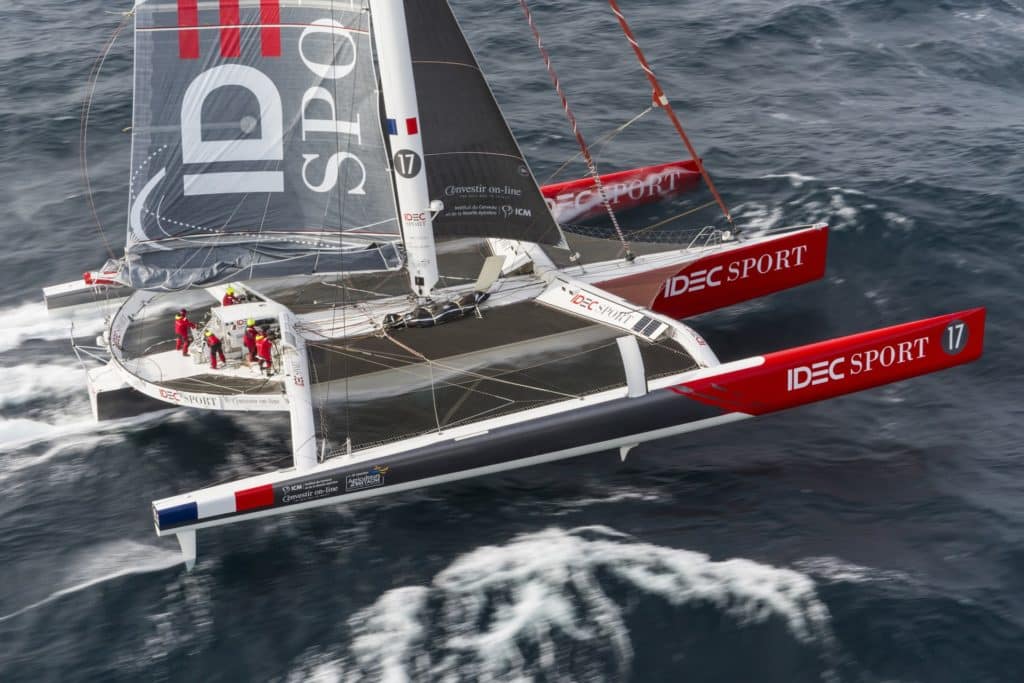
The fastest I ever traveled aboard a sailboat — one tends to remember such things — was on a gorgeous afternoon in summer 2000 aboard a 110-foot catamaran called Club Med. The boat had arrived in Newport, Rhode Island, after a trans-Atlantic training voyage in advance of an around-the-world contest called The Race, which was scheduled to begin from Spain that fall, and I’d managed to hop aboard for a test sail. Reaching across the entrance to Narragansett Bay in about 18 knots of southerly breeze, with a blurred seascape rapidly receding beneath the trampolines and the entire boat emitting a low, eerie hum, Club Med was soon piercing the light chop at a windswept 31 knots.
A couple of other interesting numbers: Club Med sailed with an international crew of 14 sailors, and the boat went on to win The Race in a time of 62d, 6h, 56m. Back then, that record-setting mark for a round-the-world voyage seemed truly remarkable, and perhaps one that would stand for many, many years to come.
Um, not so fast there, speedy.
If I needed a reminder that the world of sailing — and particularly the subset of marathon ocean races and record-smashing voyages — has changed exponentially since the turn of the century, the proof came this past Christmas Day, when a 48-year-old French sailor named Thomas Coville completed a circumnavigation aboard the 105-foot trimaran Sodebo Ultim in the blistering time of 49d, 3h, 7m. That figure is crazy, but consider this: Coville did it alone. Solo. All by himself.
Coville’s average speed over the course of his 27,325-nautical-mile trip was a ridiculous 23 knots, and he bettered the previous record, set by his fellow Frenchman Francis Joyon a dozen years earlier, by an impressive 8d, 10h. It took Coville four tries to do it, but even he had to be amazed by the final tally. Nobody could’ve imagined that a singlehanded sailor could circle the globe in less than 50 days. Heck, it took the first man to do it — Robin Knox-Johnston, in the 1968-69 Golden Globe Race — a tidy 312 days to complete the course.
Coville, a vastly experienced mariner with eight round-the-world races or record attempts under his belt, had help that wasn’t available back in Knox-Johnston’s day — a shoreside weather router — but he was also blessed with incredibly favorable conditions. It took him only 8d, 12h, 19m to cross the Indian Ocean, and just six hours longer than that to conquer the Pacific Ocean, establishing new records by a solo sailor for both passages in the process. Consider that it takes the average cruising boat about three weeks to sail from the Galápagos Islands to the Marquesas in French Polynesia — a mere fraction of the Pacific in mileage terms — and you begin to grasp the enormity of Coville’s outsize accomplishments. Meanwhile, as Coville regained his land legs and enjoyed a well-deserved rest, more records were tumbling quickly on the far side of the globe.
It’s no coincidence that 60-year-old Francis Joyon, Coville’s countryman and like-minded speed demon, was involved in one of the high-seas quests. Joyon and five crewmates set forth from the French island of Ushant on December 16 this past year aboard the 103-foot maxi trimaran IDEC Sport in hopes of capturing the Jules Verne Trophy for fastest outright time around the world, a mark that at press time stood at 45d, 13h, 42m, which was established by another French tri, Banque Populaire V, in 2012.
Exotic construction materials, better weather forecasting and route planning, the addition of foils to hulls as an offshoot to the America’s Cup: There are plenty of reasons the world is seemingly becoming a much smaller place. And let’s not forget that the major players in this rarified realm are all French, where offshore sailing is on a scale with professional football, and there are plenty of deep-pocketed corporate sponsors lining up to back these efforts.
After a while, some of these figures begin to border on the absurd. Take, for instance, the entire week in late December and early January when IDEC Sport made better than 800 miles a day — that is not a misprint — with three consecutive 24-hour runs of 876, 871 and 869 miles, respectively. That’s an average speed of 36 knots, which means there were consistent bursts over the 40-knot barrier. And I’d been impressed with my own measly top speed of 31 knots.
IDEC Sport not only toppled the Jules Verne record, taking four and a half days off the old time and setting a new round-the-world benchmark, they also set three other intermediate records along the way. Around the world in 40 days. Now that’s fast.
Still, in the grand scheme of things, it wasn’t so long ago that Jules Verne’s 80 day record seemed like a remarkable feat. At the rate they’re going, the 40 days benchmark set by IDEC Sport won’t last long.
Find out more about IDEC Sport’s record run here. —–
Herb McCormick is CW’s executive editor.








